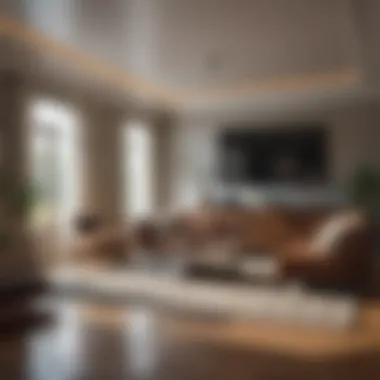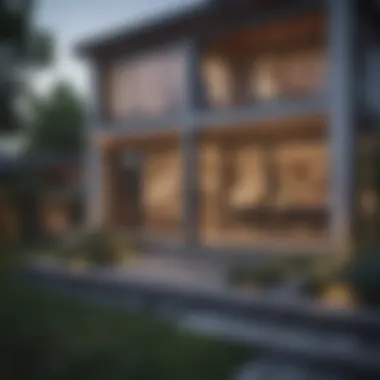Understanding Square Footage: A Comprehensive Guide


Intro
Understanding square footage is vital for anyone involved in real estate, architecture, or interior design. This measurement serves as a benchmark for property value, usability, and aesthetic appreciation. Grasping how to calculate square footage correctly provides a competitive advantage. Also, knowing its significance can help in making informed decisions. This guide will lead you through the nuances of square footage, highlighting its relevance and addressing common missteps.
Exquisite Architectural Designs
Unique Home Features
In the realm of architecture, square footage plays a crucial role in defining unique home features. Custom designs often hinge on how space is utilized. Therefore, understanding square footage can reveal how a home’s layout can enhance livability. For example, an open floor plan may seem spacious, but understanding its actual square footage allows for better furniture arrangements.
Historical Significance
Square footage also carries historical weight, particularly in architectural conservation. Homes from different periods exhibit various styles that influence their spatial dimensions. Understanding the square footage of historical buildings enables better restoration and appreciation. Thus, measuring square footage not only informs potential buyers but also helps in preserving architectural heritage.
Interior Decorating Tips
Color Schemes and Trends
When it comes to interior decorating, understanding square footage informs color schemes and layout choices. It is essential to match colors and decor to the dimensions of a space. A larger room allows for more bold color schemes, whereas smaller spaces benefit from lighter shades and simple designs. Understanding these dynamics can elevate the aesthetic appeal of a room.
Space Optimization Techniques
Efficient use of square footage is vital for optimizing space. Consider these techniques:
- Multi-functional Furniture: Pieces that serve more than one purpose can maximize space effectiveness.
- Vertical Storage Solutions: Utilizing wall space can free up floor area.
- Mirrors: Reflective surfaces can create an illusion of expanded space.
Incorporating these strategies ensures that square footage is utilized effectively, allowing space to feel more open and inviting.
"Knowing how to calculate square footage correctly empowers individuals to make informed buying or renovation decisions."
Prelude to Square Footage
Understanding square footage is a fundamental aspect that plays a significant role in various fields. This concept is not just a number but a reliable measurement that informs decisions in real estate, architecture, and interior design. For potential home buyers or renters, knowing the square footage of a property is crucial, as it directly affects value and functionality. In interior design, square footage helps designers to allocate space efficiently, ensuring that rooms serve their intended purposes without feeling cramped or excessively spacious.
Accurate square footage measurements enhance property evaluations and help communicate space effectively. Whether you are considering a purchase, contemplating renovations, or simply trying to appreciate space in your home, square footage is the foundation upon which many decisions rest. As we explore this topic, we will delve deeper into what square footage is, its relevance, and the implications of measurement accuracy in various contexts.
What Is Square Footage?
Square footage is defined as a measure of area that denotes how much floor space is contained within a given shape or structure, typically expressed in units of square feet. When aiming to estimate or measure square footage, it often refers to the ground space that a building occupies, including all usable surfaces inside the walls. In simpler terms, it reflects how much space you have at your disposal.
To calculate square footage, one needs to obtain the linear dimensions of the area in question. The formula is straightforward: multiply the length by the width. For instance, if a room measures 10 feet by 12 feet, the square footage is 120 square feet (10 x 12 = 120). Understanding how to obtain this measurement is crucial, especially for anyone involved in real estate or interior design.
Importance of Square Footage
Square footage holds considerable importance in multiple domains, functioning as a critical metric that influences many factors. In real estate, the size of a property, represented by its square footage, can greatly impact its market value. Properties with larger square footage are often priced higher because they can accommodate more living space or potential amenities.
In a similar vein, homeowners and investors need to recognize how square footage relates to property taxes. Local municipalities may assess taxes based on a property's size, meaning that accurate measurements can have financial implications.
Interior designers also rely heavily on square footage assessments. By calculating the dimensions of a space, they can make informed decisions about furniture placement, color choices, and overall design strategies. A precise square footage measurement ensures that designs fit harmoniously within the available area, optimizing usage and enhancing aesthetic appeal.
Accurate measurement of square footage not only impacts property value but also optimizes design and functional usage in any space.
Recognizing the significance of square footage enables informed decisions. As we move through this article, we will explore the methods of measuring square footage, consider its implications in real estate, and uncover common mistakes to avoid.
Measuring for Square Footage
Measuring for square footage is a vital skill in various fields, notably real estate and interior design. Accurate measurements not only influence property values but also inform decisions about space management. When understanding square footage, it is essential to grasp how to measure different types of areas effectively. This subsection explores the tools needed, a step-by-step process for measuring, and methods for calculating areas of diverse shapes. The information here will set a solid foundation for better appreciation of spatial dimensions.


Required Tools and Materials
To measure square footage accurately, certain tools are essential. Here are the materials you will need:
- Measuring Tape: A sturdy measuring tape is ideal for straight lines and large areas. A 25-foot tape is commonly sufficient for most residential spaces.
- Laser Measure: For larger properties, a laser measure provides quick and precise readings, making it easier to capture distances in seconds.
- Calculator: A simple calculator helps you perform quick computations as you work through your measurements.
- Notebook/Paper: Keeping a record of measurements is necessary to avoid confusion later.
- Flat Surface: Ensure the area being measured is as flat as possible. Uneven surfaces can affect accuracy, especially in irregular designs.
Step-by-Step Measuring Process
- Prepare the Area: Remove furniture or obstructions in the room. This allows full access to walls and corners, enabling a more accurate measurement.
- Measure Length and Width: Use the measuring tape or laser measure to determine the length and width of the room or area.
- Calculate Square Footage: Multiply the length by the width to find the square footage for rectangular spaces. For example, a room that is 10 feet long and 12 feet wide has a square footage of 120 square feet.
- Document Measurements: Write down each measurement as you take it. This will help maintain clarity when calculating total areas.
- Repeat as Needed: If measuring multiple rooms or spaces, repeat the process for each one, keeping the measurements organized.
Calculating Areas of Different Shapes
Calculating areas may vary depending on the shapes involved. Understanding each shape's specific rules simplifies this task.
Rectangular Areas
Rectangular areas are the most straightforward for calculations. Their structure allows for easy multiplication of length and width. The unique feature is their predictable geometry, resulting in a direct formula:
Area = Length × Width.
This simplicity makes rectangular areas a preferred calculation for residential and commercial spaces.
Advantages of this method include rapid calculations and clarity in property descriptions. However, it may not reflect complex layouts often seen in modern design.
Circular Areas
Circular areas require a different approach. The key aspect is the radius of the circle. To find the area, the formula is:
Area = π × (Radius²).
This reflects the circle’s geometry, making it advantageous for spaces such as round rooms or gardens.
Though circular measurements can complicate averages for square footage, they provide a unique perspective on design possibilities beyond standard shapes.
Irregular Shapes
When dealing with irregular shapes, the measuring process becomes intricate. The main challenge lies in estimating areas that do not conform to standard geometric formulas. One popular method involves breaking the irregular shape into smaller, regular shapes (like triangles or rectangles) and calculating their individual areas before summing them up.
This approach allows for flexibility in various designs, capturing properties with unique layouts. However, calculating these areas requires careful attention to detail to ensure accuracy, which may intimidate some from attempting it.
Drawing accurate floor plans and measurements is invaluable in navigating and understanding any space effectively.
In this section, good measuring practices are crucial. Mastering the techniques for measuring square footage will enhance one’s ability to evaluate spaces, whether they are homes, offices, or any environment requiring planning and design.
Understanding Square Footage in Real Estate
Square footage plays a significant role in real estate. It is not just a number; it influences decisions by buyers, sellers, and agents alike. Understanding how square footage is calculated and its implications can greatly impact property value and desirability. The way properties are measured can vary, leading to discrepancies that might confuse potential buyers or investors. Cultural differences in measurement practices can also lead to misunderstandings depending on the region.
Establishing accurate square footage is essential for maintaining fair market value. If a house is listed with inflated square footage, potential buyers might feel misled. Conversely, listing a property with understated square footage may lead to underpricing and loss in potential revenue. Therefore, accurate square footage is foundational in ensuring that properties are positioned correctly in the market.
Square Footage and Property Values
The relationship between square footage and property values is complex. Generally, larger properties tend to command higher prices, but this is not always straightforward. Factors such as location, condition, and architectural style also play critical roles. In urban areas, a smaller apartment can have a higher price per square foot than a larger suburban home.
When assessing value, many use a price per square foot metric to compare properties. This is calculated by dividing the property price by its square footage. A property’s price per square foot can serve as a benchmark for buyers. However, it is crucial to consider the context, such as amenities or recent renovations, that can greatly alter valuations.
Key Considerations:
- Property Age: Older homes may have a different value per square foot compared to newly constructed homes.
- Neighborhood Trends: Real estate values can fluctuate based on the performance and desirability of the neighborhood.
- Market Conditions: In seller's markets, square footage may not reflect true value as demand drives prices.
How Agents Use Square Footage


Real estate agents heavily rely on square footage in their marketing strategies. They utilize data on square footage to develop competitive market analyses and help clients set realistic pricing. Agents also emphasize square footage in listings, as many buyers filter their searches based on this figure.
Listing descriptions often highlight square footage to attract potential interest. A larger size can suggest spaciousness, which many buyers seek.
"When agents present a property, they are not just selling a house; they are conveying a lifestyle that square footage helps to define."
Furthermore, agents also advise clients on pricing strategies based on square footage, helping them understand how to position their properties effectively in the market. By comprehending square footage's implications, both sellers and agents can navigate real estate transactions with greater insight.
Square Footage for Interior Design
Square footage greatly influences interior design choices. It helps in understanding the available space within a room or an entire property. Designers and homeowners must grasp how to use square footage calculations effectively to achieve desired aesthetics and functionality. The proper use of space can elevate style while maintaining comfort.
Determining Room Dimensions
To effectively plan an interior space, it is crucial to first determine the room's dimensions. This includes measuring the length and width with accuracy. Knowing the square footage allows for better decisions on what can fit, including furniture and decorative elements. It also helps in visualizing how different design elements come together.
Additionally, understanding the overall dimensions enables one to assess more intricate details, like ceiling height or architectural features. Measuring correctly can avoid costly mistakes in purchasing items that might not fit your intended layout.
Space Management Strategies
For interior design, managing the space well is vital to create a harmonious environment. Here are two key strategies to consider:
Furniture Placement
Placement of furniture is a fundamental aspect of interior design. Proper spacing leads to a visually balanced room. It allows for movement and contributes to the overall flow of a space. Effective furniture arrangement can also define areas, such as creating a sitting area in a living room.
One unique feature of furniture placement is the ability to accentuate positive aspects of room geometry. For example, arranging furniture to highlight a fireplace or a window. However, it can be challenging when dealing with smaller rooms. In such cases, oversized pieces can overcrowd the area, making it feel cramped.
Traffic Flow Considerations
Traffic flow is another critical factor in interior design. It determines how people navigate through a space. A key characteristic of good traffic flow is maintaining clear pathways. This usually involves careful consideration of the arrangement of furniture.
Creating open pathways encourages movement and makes it easy to transition from one area to another. The placement should facilitate both comfort and functionality. A downside, however, can be the limitation that certain furniture layouts can impose. Therefore, ensuring that functionality and design coalesce is essential.
Good flow enhances the user experience in any space, making it more enjoyable.
In sum, utilizing square footage wisely in these strategies not only enhances aesthetics but also boosts usability in interior design. Understanding these concepts allows individuals to make more informed choices when designing their spaces.
Common Mistakes in Calculating Square Footage
Calculating square footage accurately is essential for various reasons, such as property value estimation, interior design, and legal compliance. However, numerous common mistakes can compromise accuracy. Understanding these miscalculations can prevent pitfalls. This section highlights frequent errors, providing insight into their implications and significance.
Estimating vs. Exact Measurements
Many individuals rely on estimations when measuring square footage. This approach may seem easy, but it often leads to inaccuracies. When a person estimates, there is a tendency to overlook the minutiae that can have a significant impact on the final number. For instance, slight fluctuations in dimensions can lead to substantial differences in overall square footage, particularly in larger spaces.
Using exact measurements is crucial when calculating square footage. Exact measurements involve using tools such as a measuring tape, laser distance measurers or even digital apps. These methods yield more accurate results, allowing for proper assessments of space. To achieve a precise calculation, every room must be measured meticulously, including all nooks and subdivisions. An accurate measure provides a reliable basis for decision-making, particularly in contexts where square footage is linked to financial outcomes, such as buying or selling property.
Ignoring Architectural Features
In the quest for accurate square footage, architectural features often become overlooked or misunderstood. Elements like recesses, alcoves, and protrusions can skew measurements if not accounted for. An architect's design often includes features that may not contribute to usable space, but they affect the overall square footage.
Failing to include these elements can lead to inflated or deflated property values. For example, a room with a large column or a fireplace might reduce usable space but still count toward the total area. Hence, accurate reflection of these features is essential when evaluating property. For anyone involved in real estate or design, recognizing the impact of architectural details on measurements cannot be underestimated. Taking the time to factor in these aspects will contribute to better-informed choices and enhance the overall understanding of a property's space.
Square Footage Regulations and Standards
Square footage regulations and standards are critical for various stakeholders in real estate, construction, and interior design. Understanding these frameworks ensures that measurements are consistent and reliable, promoting transparency in the marketplace. Compliance with these regulations not only enhances property valuation but also protects consumer rights. Many people overlook the significance of these standards; however, they are vital for personal and financial decisions.


Building Codes Overview
Building codes are a set of regulations that detail proper construction practices. They include specifications about materials, structural integrity, and safety measures. In the context of square footage, building codes dictate how measurements must be taken. This ensures that all properties adhere to uniform standards, providing clarity and safety. Different regions may have unique codes, which can affect how square footage is calculated and reported.
For example, in many jurisdictions, finished basements and attics may or may not count towards total square footage, depending on the height and accessibility. Homeowners must know local codes to avoid discrepancies in property listings. Inaccurate square footage measures can lead to financial implications, such as tax discrepancies or undervaluation during sales.
"Building codes unite builders and homeowners, ensuring every structure is safe, sound, and correctly measured."
Industry Standards for Measurement
Industry standards for measuring square footage serve as guidelines that help ensure accuracy across various fields. These standards are often defined by professional organizations and are essential for maintaining consistency in property listings, appraisals, and transactions.
Some accepted norms in the industry include:
- Measurement Methods: Standards outline the acceptable techniques for measuring various spaces. This includes considerations for the measurement of gross square footage versus livable square footage.
- Documentation Requirements: Proper documentation should accompany measurements. This can include plans, sketches, and reports that indicate how the square footage was determined.
- Exclusions: Standards often specify which areas cannot be included, such as structural features (e.g., walls and columns), external balconies, and mechanical spaces.
Adhering to these industry standards is not just helpful; it is necessary for maintaining credibility and professionalism. Real estate agents, appraisers, and architects must follow these guidelines to ensure their work is recognized and respected.
Ultimately, understanding square footage regulations and standards enriches the experience for all parties involved, thereby forming a foundation for trust in real estate transactions.
Software Tools for Measuring Square Footage
In today’s digital age, software tools for measuring square footage have become essential. Traditional measuring methods, while effective, can be time-consuming and prone to human error. With advancements in technology, dedicated software and applications make the process not only efficient but also precise. Understanding these tools allows real estate enthusiasts, interior designers, and contractors to optimize their workflows and achieve accurate measurements effortlessly.
Digital Measurement Apps
Digital measurement apps are powerful resources for anyone looking to measure square footage. These applications can turn your smartphone into a measuring tool, utilizing the device's camera and sensors.
Some of the key advantages include:
- Ease of Use: Most apps are user-friendly and designed for simplicity.
- Instant Results: Users receive immediate measurements, saving valuable time.
- Storage Options: Many apps allow saving measurements and notes directly on the device.
One notable app is MagicPlan, which enables users to create floor plans by simply pointing their camera around a space. Other apps, such as RoomScan and Floor Plan Creator, offer features like adding doors and windows, giving a more comprehensive view of a space. These tools can be particularly beneficial during property assessments and renovations.
CAD Software for Professionals
For professionals in architecture and engineering, precise square footage measurements are crucial. Computer-Aided Design (CAD) software serves as an industry standard in this field.
Professional CAD programs, like AutoCAD and SketchUp, provide advanced capabilities to create detailed floor plans and 3D models.
Benefits of CAD software include:
- Precision: Allows highly accurate measurements with complex calculations.
- Versatility: Supports multiple design functions, providing a comprehensive suite for project completion.
- Collaboration Features: Facilitates sharing among teams, improving communication and workflow.
You can generate automatically calculated square footage in real time as you design your projects, ensuring thoroughness that is often missing from manual calculations. This level of detail is especially important in commercial settings where understanding space utilization is imperative.
Culmination
Understanding square footage is vital for numerous domains including real estate, architecture, and interior design. It encapsulates essential metrics that dictate property values, effective space utilization, and accurate renovations. A strong grasp of square footage can empower individuals to make informed decisions, ensuring they maximize both their investments and their living spaces.
Recap of Key Points
- Definition: Square footage quantifies the area in a space, essential for various applications.
- Measurement Techniques: Accurate measuring requires specific tools and a methodical approach. Knowing the right steps and calculating areas for different shapes is critical.
- Real Estate Significance: Square footage plays a crucial role in property valuation and is utilized by real estate agents for market analysis.
- Interior Design Implications: It influences room layouts and space management strategies, where practical considerations dictate effective design.
- Common Mistakes: Awareness of common errors can help avoid pitfalls in measurements, such as estimating versus exact calculations.
- Standards and Regulations: Familiarity with building codes and industry standards ensures compliance and accuracy in square footage calculations.
- Software and Tools: Digital solutions streamline measuring processes, enhancing precision and efficiency.
Final Thoughts on Square Footage
Recognizing the full scope of square footage dynamics extends beyond mere calculations. It encompasses considerations about space efficacy and investment potential. Whether one is buying a home, undertaking renovations, or designing an interior, understanding square footage leads to better outcomes.
In today's real estate climate, informed decisions are paramount. Acknowledge the nuances of square footage to strategically enhance your living and working environments.
"Knowledge is power. It is imperative that individuals fully understand the measurements that govern their environments."
This comprehensive guide serves as a foundation for deeper exploration into square footage and its implications. As you engage with this information, consider the role that accurate measurement plays in your own space decisions.















